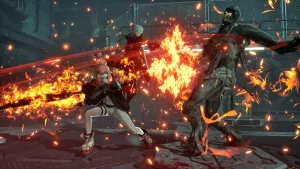Batman: Arkham Origins Review

Gotham City is oddly silent on Christmas Eve. No taxis shuttle
last-second shoppers to toy stores. No children visit Santa Claus to
make sure he knows exactly what they want to see under their trees. The
only commotion on the city’s streets is the fluttering of snowflakes,
warning of a storm.
Even with Gotham’s citizens
embracing the warmth of their homes on this joyous night, Batman is hard
at work. Black Mask, the head of the city’s largest crime organization,
infiltrates Blackgate Penitentiary to snuff out police commissioner
Gillian Loeb. As Batman races to save Loeb’s life, he learns that Black
Mask’s plot extends to another target: He wants Batman dead. A sizeable
purse goes to the assassin who delivers his corpse. Eight of Gotham’s
most feared killers receive this invitation, and Batman knows they are
coming for him.
This is an intriguing introduction for a Batman
story. Gotham’s sworn protector isn’t eliciting fear into others on this
night. He’s the prey. He’s on edge. He knows he’s a target. He just
doesn’t know when or how he will be attacked.
I was fully onboard
with this premise, but it never truly takes root as the central focus.
Other story threads pollute the hunt; a thin lead puts Penguin in the
crosshairs, the Falcone family gets involved, conflict arises with
Gotham City’s police department, Anarchy seeks citywide mayhem, Black
Mask becomes a part of a greater mystery. Batman has his hands full. The
assassins are pushed to the back of the mind, and most of these deadly
foes become stopgap boss battles (two of these bouts even take place in a
dedicated combat arena). That’s not to say that the various story
threads are unwanted or void of compelling events. I enjoyed most of
these arcs, but for the first third of the game, there isn’t a cohesive
narrative to follow; it’s more a scattershot of mini-tales.
But
just when it seems this story could become even more convoluted through
additional developments, a sinister smile creeps across the screen. At
that point, the plot is given new life filled with clarity and
excitement. Some of the other threads continue on, but the Joker takes
over and it becomes his game.
He’s revealed in a plot twist that
is shades of Scooby Doo silly, but most of his story is mesmerizing,
diving deep into his psyche to illustrate his disturbing first moments
as Gotham’s clown prince. Actor Troy Baker (replacing the great Mark
Hamill) does a remarkable job mimicking Joker’s haunting voice from the
first two Arkham games. Roger Craig Smith’s interpretation of Kevin
Conroy’s Batman is also incredibly close. The title “Arkham Origins”
speaks mostly of these characters’ first encounter, which is a new take
outside of the comic and movie lore.

Voice acting aside, the most impressive form of imitation comes from developer Warner Bros. Montreal, which is faced with the tall task of creating a prequel game to Rocksteady’s incredible run with the Bat. Although we’re looking at a younger Bruce Wayne, he’s the same physical specimen we’ve come to know over the years, relying on various martial arts and a familiar arsenal of gadgets to topple his opponents and explore his fair city.
|
Don’t Bother With Multiplayer
You won’t be missing anything if you never click the “Online” option. After finding moderate success with Monolith Productions’ Gotham City Impostors, Warner Bros. has enlisted the talents of Splash Damage (the studio behind Brink) to re-envision a Batman multiplayer experience. While offering the unique set-up of 2 vs. 3 vs. 3 (Batman and Robin versus three of Joker’s henchmen versus three of Bane’s), the shoddy gunplay kills the experience. Sure, stealthily taking out players as Batman or Robin is fun, but most of your time is spent as the inept villains. Playing as Joker and Bane (who can be controlled by one player mid-match) is empowering to a degree, but overall, this multiplayer package brought back nightmares of fighting other players (and the controls) in BioShock 2’s competitive component. |
Combat scenarios play out with the same levels of grace and brutality
that we’ve seen in the past, pushing the player to use attacks,
counters, cape strikes, and an array of gadget abilities to
strategically chain together impressive combos. New animations are
peppered in (including less painful strikes against police officers),
but it’s very much the same satisfying song and dance we've seen before.
Traversal once again combines the Bat-claw, glide, and dive bomb
techniques as a means of soaring across Gotham. Detective Vision is used
frequently for stealth sequences, and to reveal secrets hidden from
plain sight.
The gameplay rarely breaks free from being more of
the same. Warner Bros. Montreal uses this formula to deliver sizable
thrills, but many sections use recycled gameplay techniques ad nauseam.
Batman’s cryptographic sequencer, for instance, is tapped so often that
it almost becomes comedic. It's used eight times alone in the GCPD.
Before Gotham was turned into a prison, it was apparently a
password-protected nightmare.
The gadgets come across as Warner
Bros. trying too hard to emulate Rocksteady’s formula. The glue
grenade, which replaces the freeze grenade, handles the same function of
gumming up deadly steam vents, and, well... “I need to use my glue
grenade to make a raft,” Batman says. A glue raft? Is that even
scientifically possible?
In the later stages of Batman’s quest, he obtains a pair of shock
gauntlets that are similar in concept to BAT mode from Arkham City's
Armored Edition. No foe can withstand the might of these kinetically
powered devices. Shield carriers, larger heavy units, and any foe you
come across in standard combat situations can be knocked down or
weakened with one shock gauntlet strike. Sure, it’s enthralling to
control a version of Batman that doubles as an electrically charged
pinball on the battlefield, but above all else, the shock gauntlets
break the careful balancing of combat. Finding windows to disarm shield
carriers and stun heavy units is an integral part of Arkham’s intense
combat. Removing those elements leads to mindless brawling, and that’s
what this game becomes in its final leg.
The most enjoyment I got
out of Arkham Origins came from Joker’s story, and a few of the
gameplay scenarios tied to specific villains. Mad Hatter takes Batman on
a crazy adventure that showcases fantastic environment designs. An
encounter with Firefly unfolds across unstable terrain and impressive
setpiece moments. I also liked Warner Bros. Montreal’s new take on
investigations. They favor science fiction-like ideas over traditional
sleuthing to show us exactly how the crimes were committed. They get
fairly complicated, and give us a good look at how Batman breaks down
crime scenes.
Gotham City is considerably larger than
Arkham City’s walled-off version, but that doesn’t mean more time is
lost to gliding between destinations. Fast travel stations are placed in
each borough, and the city is designed in a way that allows Batman to
stay airborne with the Bat-claw. If you don’t use fast travel, Gotham
Pioneers Bridge is enormous and takes a considerable amount of time to
navigate.
This world is littered with secrets and
villain-specific side activities. Riddler returns as a welcome foe that
has hidden extortion files all across Gotham. For those of you who will
track all of them down (a doable feat with a handy in-game locator) and
aspire to hit 100-percent completion, Challenge mode is loaded to the
hilt, pushing players to collect 288 gold medals. And if you really want
to dive into this game, New Game Plus is once again unlocked after the
story concludes. There’s also I am the Night mode, which only offers one
life and no saves.
Batman: Arkham Origins delivers more of what made Rocksteady's games great, but doesn't break new ground. Like a youthful Bruce Wayne, it isn’t as crafty, and it takes its dings during combat, but still puts on a hell of a show when it needs to. Once Joker steps into the spotlight, it becomes a hard game to put down.

Get the Game Informer Print Edition!
Explore your favorite games in premium print format, delivered to your door.
- 10 issues per year
- Only $4.80 per issue
- Full digital magazine archive access
- Since 1991










